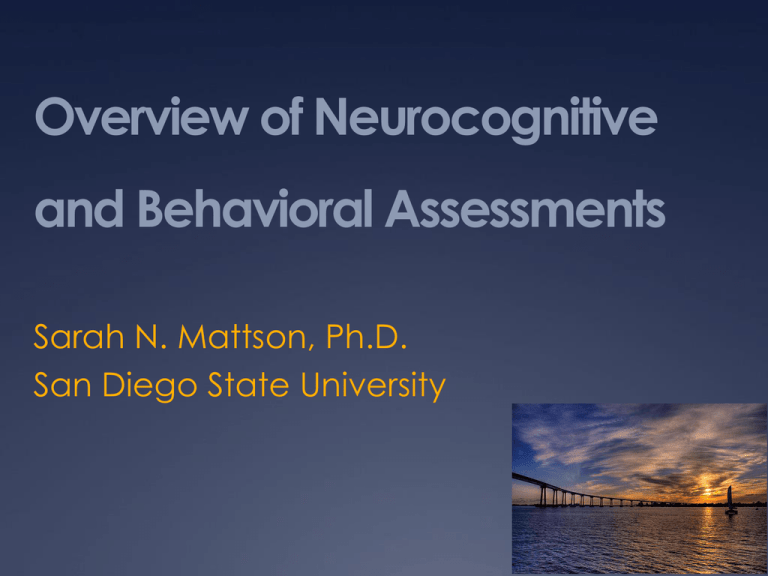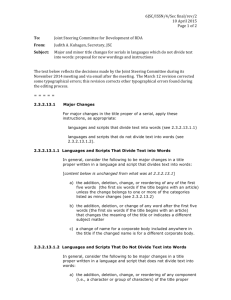Overview of Neurocognitive and Behavioral Assessments
advertisement

Overview of Neurocognitive and Behavioral Assessments Sarah N. Mattson, Ph.D. San Diego State University Outline of Presentation Overview of assessments General ability measures Social and communication behavior Behavior ratings Findings from previous assessments General Ability Measures Bayley-III: Bayley Scales of Infant and Toddler Development-third edition Ages: 1 to 42 months Administration time: 45-60 minutes DAS-II: Differential Abilities Scale-second edition Ages: 2:6 to 17:11 years Administration time: ~45 minutes WAIS-IV: Wechsler Adult Intelligence Scale-fourth edition Ages: 16:0 to 90:11 years Administration time: ~60 minutes Social and Communication Behavior ADOS: Autism Diagnostic Observation Schedule Description: a semi-structured assessment used to evaluate social and communication behavior across developmental levels and ages Ages: toddlers to adults Administration time: 30-45 minutes Behavior Ratings VABS-II: Vineland Adaptive Behavior Scale-second edition Questionnaire and interview format Assesses adaptive behavior (personal and social skills needed for daily living) SCQ: Social Communication Questionnaire Assesses communication skills and social functioning CBCL: Child Behavior Checklist Assesses adaptive and maladaptive behavioral functioning DBD: Disruptive Behavior Disorder Rating Scale Assesses disruptive behaviors like those seen in ADHD Research Involvement Location: San Diego State University Direct assessment ~2 hours to complete assessments Parent assessment ~1-2 hours to complete questionnaires ~1 hour to complete interview at CBT Compensation: ~ $20 financial incentive and feedback from testing Previously Reported Delayed development, including motor and speech Mild to severe intellectual disabilities Learning difficulties Behavior Problems including compulsive behavior, short attention span, distractibility Results from Ongoing Research Parent and Child Questionnaire Medical Issues Developmental Milestones School & Behavior Behavior Ratings Relation to Deletion Size Medical Issues N % Heart Problems 22 75.9% Heart Surgery 7 24.1% Blood Problems 25 86.2% Ever Hospitalized 22 75.9% CT Scan or MRI of Brain 21 72.4% Seizures 4 13.8% Current Meds 20 69.0% Feeding or Eating Problems 22 75.9% Gastrointestinal Problems 20 69.0% Recurring Infections 21 72.4% Hearing Problems 19 65.5% Vision Problems 24 82.8% Data from 2006/2008, N = 29 Developmental Milestones Crawl Typical Development 9 Age in Months “Not Yet” MN (SD) N (%) 17.96 (8.13) 1 (2.9%) Eat solid foods 6 17.72 (13.18) 0 (0.0%) Sit up without support 9 13.45 (5.86) 0 (0.0%) Say first word 12 25.30 (11.95) 0 (0.0%) 12-18 28.84 (15.13) 1 (2.9%) 24 48.71 (20.22) 7 (20.0%) Walk Stay dry during the day Data from 2006/2008, N = 35 School & Behavior N % Attends School 27 93.1% Special Education 26 89.7% Repeated Grade 5 17.2% Other Special Services 27 93.1% Any Behavior Problems 21 72.4% Dx ADHD 12 41.4% Dx Learning Disability 15 51.7% Data from 2006/2008, N = 29 Behavioral Functioning 80 T-Score 70 60 50 JS 40 Scale Behavioral Functioning 80 T-Score 70 60 JS 50 DS 40 Scale IQ Estimate Deletion Size & IQ 85 80 75 70 65 60 55 50 45 40 7 9 11 13 15 17 Deletion r = -.83 Deletion Size & Adaptive Behavior VABS Composite 120 110 100 90 80 70 60 50 40 7 9 11 13 15 17 Deletion r = -.58 Deletion Size & Behavior CBCL Total T-Score 90 80 70 60 50 40 7 9 11 13 15 17 Deletion r = -.71 Summary So Far… Behavioral assessments support previous reports and may be unique from other developmental conditions Understanding the relation between deletion size and cognition and behavior will provide important information that will help families, especially those with new diagnoses Plans for the Future Further examine our existing data and continue to collect new information Seek external funding for research activities We couldn’t do this without you - THANK YOU!











